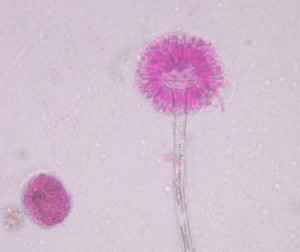Bob was working in an office that was part of a larger warehouse/manufacturing facility. He was allergic to mold, and he, along with several other employees, experienced asthma symptoms at work; during humid weather he noted a musty odor. The office area was carpeted, and the carpet was on concrete that was resting directly on soil (slab-on-grade). There were carpet-protector mats under each desk chair, and holes had been drilled in some of the mats because trapped moisture sometimes condensed on the back side of the plastic. According to the builder, no vapor barrier had been placed on the soil prior to pouring the concrete for the slab.
(Comment: The concentration of mold spores indoors was not very different from the concentration outdoors, despite traffic on the carpet. Directly underneath the mats, though, the dust in the carpeting was severely infested with mites and Aspergillus mold. Moisture from the soil was passing through the concrete into the carpet, and the plastic mats were preventing evaporation. When chairs rolled over the mats, air flow from the holes contained Aspergillus spores.)

On the right is the flower-like spore bearing structure of Aspergillus mold growth. The spores are small and readily aerosolized and inhaled deeply into the lung. On the left is a fecal pellet from a mite that was foraging on the mold. The spore-filled fecal pellet and Aspergillus spores are colored pink by the added stain.
© 2025 Jeffrey C. May, M.A.
